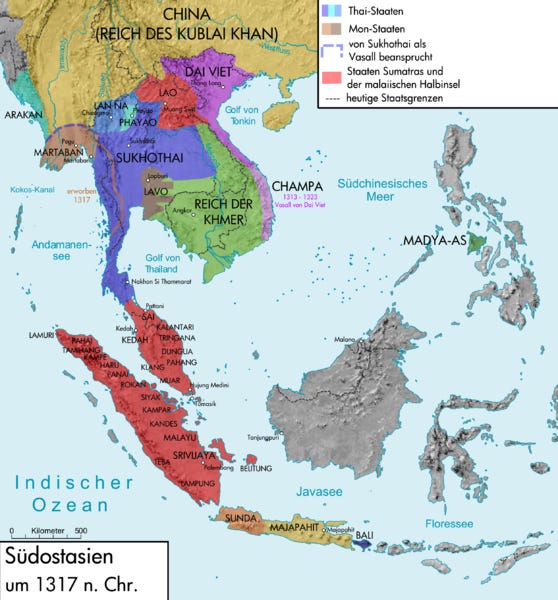Stopping the Mongol Juggernaut 101
Three-lesser known Asian kingdoms who put the brakes on the Mongol world conquest

“ Empires are like Ponzi schemes: financial frauds in which previous investors are paid returns out of new investors’ deposits. The costs of holding imperial territory can only be underwritten by loot and tribute extracted by constant new conquests”- Paul Kriwaczek.
The quote by Paul Kriwaczek is from his book Babylon: Mesopotamia and the Birth of Civilization. It was about the Assyrian Empire, but this is true for every empire in human history, including the Mongol Empire.
Under Chinggis Khan’s leadership, the Mongols built the world’s largest contiguous land empire. After he died in 1227, infighting caused the Mongol Empire to fall apart within three decades. Their opponents had figured them out. The Mongols met their match on the battlefield, shattering their aura of invincibility.
The defeat of the Mongols by Egypt’s Mamluk Sultanate at Ain Jalut in 1260 marked the beginning of their downfall. The Mongols also failed to conquer Japan in 1281, as a storm sank the invading fleet. The hurricane, known as kamikaze (meaning divine wind), has inspired many works of literature, movies, and video games.
The Mamluks and the Japanese played crucial roles in stopping the Mongol advance. However, lesser-known kingdoms from Vietnam, Indonesia, and India also resisted the Mongols, preventing the empire from achieving global domination. The failure to conquer these Asian kingdoms contributed to the eventual collapse of the Mongol Empire, as the expensive military campaigns depleted its treasury.
Let’s learn how largely forgotten rulers from Vietnam, Indonesia, and India halted the Mongol storm. The Japanese and Mamluk victories over the Mongols are widely known; hence, we won’t focus on them in this story. We’ll start our journey against Mongol resistance in Vietnam, a graveyard of empires throughout history.
Reminder: By choosing a paid membership (just $5 a month or $50 annually), you’re helping amplify voices that history books too often overlook. Your support means these stories get the attention they deserve.
You’ll gain access to tons of members-only content👇
Full-length deep dives into untold stories: no paywalls, no cuts.
The entire archive of amazing stories from the Ice Age to the Fall of the Mongol Empire, the hottest archaeological finds, and the appetizing history of food.
Early access to special editions—be the first to dive in.
Join lively discussions in members-only posts and subscriber chats.
Dai Viet and Champa, Vietnam

The Vietnamese kingdoms of Dai Viet and Champa were bitter rivals. But, during the Mongol invasions, both worked together to protect the country.
The Mongols launched their first invasion of Dai Viet in 1258 to encircle the Song Dynasty. The Southern Chinese Song Dynasty was the world’s wealthiest and most industrialized empire, and the Mongols had an eye on its riches.
Uriyangkhadai, the son of the famed Mongol general Subutai, led the invasion of Dai Viet. The Vietnamese forces proved no match for the Mongols, who routed them and sacked the capital, Thang Long (modern Hanoi). But the Vietnamese resorted to a scorched-earth strategy, and urgent matters in China forced Uriyangkhadai and the entire Mongol army to be recalled.
Following the encounter in 1258, there was peace for 25 years. Dai Viet and Champa decided that paying tribute to the Mongol Khan was the best way to maintain peace.
Things changed when Kublai( pronounced as Khubilai in Mongolian) became the great Khan of the Mongols in 1260. He was based in China and founded the Yuan Dynasty.
After the Song Dynasty’s conquest in 1279, Kublai demanded that the kings of Champa and Dai Viet come and surrender to him in person. Neither ruler wanted to do so. In 1282, the Mongol general Sogetu invaded Champa. The Champa prince, Harijit, had arrested Yuan envoys, providing the Mongols with a perfect excuse for an attack.
In the beginning, Sogetu did well. He captured Vijaya, the Champa capital, forcing King Indravarman and Prince Harijit to flee. But they burned down the countryside, leaving the Mongols without food. A two-year guerrilla fight ensued, with the Mongols suffering heavy casualties.
Then, in early 1285, Kublai’s son, Toghon, attacked Champa with Omar as his fleet commander. They planned to join Sogetu.
Dai Viet was not in the mood to help them.
Keep reading with a 7-day free trial
Subscribe to Forgotten Footprints to keep reading this post and get 7 days of free access to the full post archives.

